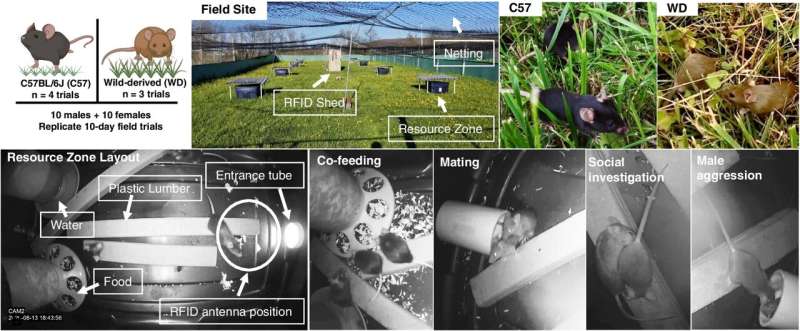This article has been reviewed according to Science X's editorial process and policies. Editors have highlighted the following attributes while ensuring the content's credibility:
fact-checked
trusted source
proofread
When placed outdoors, female lab mice behave very differently

When you take the lab away, female mice are more likely to play, according to a new Cornell study.
The study, published in the journal BMC Biology, took lab mice and placed them in large outdoor enclosures. The researchers found that male behavior was essentially the same as genetically wild mice, but females displayed radically different behaviors. It's the first study to examine the social behavior of lab mice in large outdoor enclosures.
"Given how much of biomedical research is carried out on a single strain of lab mice, it is critical that we understand them as organisms," said senior author Michael Sheehan, associate professor of neurobiology and behavior in the College of Agriculture and Life Sciences (CALS). Caleb Vogt, a doctoral student in Sheehan's lab, is the paper's first author.
"The findings have broad implications for all biomedical studies using lab mice but especially those that use mice as a model of social behavior," Sheehan said. At the same time, the study's insights don't necessarily invalidate previous research, he said.
"Our results highlight that we need to be careful about what we take as the baseline," Sheehan said, since environment (and more space) has a noticeable effect on some behaviors.
In the study, the researchers compared the most studied lab mouse strain—genetically uniform C57BL/6J—against house mice whose ancestors were caught in upstate New York and have been outbred, so every individual is genetically distinct.
In each replicate trial, 10 male and 10 female C57 mice were placed in 5,000-square-foot enclosures for a 10-day trial and were compared to control trials with genetically wild mice. Within each enclosure, the researchers placed eight tote containers, each with food, water, and holes for mice to enter and exit. Each tote had an RFID (radio frequency identification) reader in it, and each mouse was fitted with a distinct tag so they could be identified and recorded whenever they entered and exited a tote.
After collecting 9 million data points and analyzing them using a system Vogt developed, the researchers found that male C57 mice and wild mice behaved similarly to each other when placed outdoors. In the lab, mice are housed with other mice in shoebox-sized cages. When space is limited, they create a hierarchy where a dominant male rules the area. But when placed outdoors, males will establish their own territories.
"Which is exactly what people have reported from wild mouse populations: When you give them space, a fundamental feature of their social structure is that they will make territories—a behavior that we simply can't study in the lab," Sheehan said.
There were eight boxes and 10 males, so a few males ended up without a territory and floated around. The males who claimed a territory did visit other boxes, but the mouse whose territory it was overwhelmingly ended up remaining, while others left after interacting. Males with territories spent more time in their homes, as females roamed and visited different boxes, so these males spent more time with females by staying put.
Much like males, when wild females have plenty of space, they avoid each other as they compete for food or nesting resources. They differ from males in that sometimes, multiple females will share a space together, and when they do, it is with sisters. The lab females in spacious enclosures, on the other hand, often go everywhere, every night, sometimes visiting every box.
"The lab females also don't show any preferential interactions with their sisters; they essentially interact randomly with every other female," Sheehan said.
Since all the lab mice are genetically identical, it is hard to know whether the behavioral differences between wild and lab mice occur because it is harder for individual lab mice to tell each other apart or if there is a more fundamental difference in their social structures, Sheehan said.
The study also revealed that when left to themselves with plenty of space, the mice choose to spend more than half their time alone. In the lab, mice spend their entire lives in small cages with up to four other mice. The findings could have relevance to studies that examine social isolation as a predictor of health, Sheehan said.
The researchers also found that these results were highly repeatable between trials. Despite all the complexity of social interactions in large groups, given the same initial starting conditions, the two genotypes reliably produced different social structures.
"It opens the door to experimentally manipulate the demographic or genetic composition of free-living populations to ask questions about how realistic natural social environments affect health, fitness, and life outcomes for individuals," Sheehan said.
More information: Caleb C. Vogt et al, Female behavior drives the formation of distinct social structures in C57BL/6J versus wild-derived outbred mice in field enclosures, BMC Biology (2024). DOI: 10.1186/s12915-024-01809-0
Provided by Cornell University





















